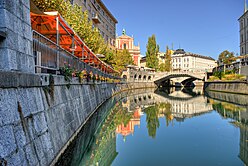
Back Ljubljana ACE Ljubljana Afrikaans Ljubljana ALS ልዩብልያና Amharic Ljubljana AN ليوبليانا Arabic ليوبليانا ARZ Liubliana AST Ljubljana AVK Lyublyana Azerbaijani
Ljubljana | |
|---|---|
View of Ljubljana from Nebotičnik One of the dragons on the Dragon Bridge Ljubljanica with the Triple Bridge in the distance | |
| Coordinates: 46°03′05″N 14°30′22″E / 46.05139°N 14.50611°E | |
| Country | |
| Municipality | City Municipality of Ljubljana |
| Statistical region | Central Slovenia |
| First mention | 1112–1125 |
| Town privileges | 1220–1243 |
| Roman Catholic diocese | 6 December 1461 |
| Government | |
| • Mayor | Zoran Janković (Zoran Janković List) |
| Area | |
| • Capital city | 165[1] km2 (64 sq mi) |
| • Metro | 2,334 km2 (901 sq mi) |
| Elevation | 295 m (968 ft) |
| Population (2020)[3] | |
| • Capital city | |
| • Density | 1,712/km2 (4,430/sq mi) |
| • Metro | 537,893[2] |
| Time zone | UTC+1 (CET) |
| • Summer (DST) | UTC+2 (CEST) |
| Postal codes | 1000–1211, 1231, 1260, 1261[4] |
| Area code | 01 (+386 1 if calling from abroad) |
| Vehicle Registration | LJ |
| Website | www |
Archbishop of Salzburg (1112–1555)
Habsburg Monarchy (1555–1804)
Austrian Empire (1804–1809)
Illyrian Provinces (1809–1814; capital)
Austrian Empire (1814–1867)
Austria-Hungary (1867–1918)
State of Slovenes, Croats and Serbs (1918)
Kingdom of Yugoslavia[5] (1918–1941)
Kingdom of Italy (1941–1945; annexed)
Nazi Germany (1943–1945; de facto)
SFR Yugoslavia[6] (1945–1991)
Slovenia (1991–present; capital)
Ljubljana[a] (also known by other historical names) is the capital and largest city of Slovenia,[14][15] located along a trade route between the northern Adriatic Sea and the Danube region,[16] north of the country's largest marsh, inhabited since prehistoric times. It is the country's cultural, educational, economic, political and administrative center.
During antiquity, a Roman city called Emona stood in the area.[17] The city was first mentioned in the first half of the 12th century. It was the historical capital of Carniola,[18] one of the Slovene-inhabited parts of the Habsburg monarchy.[14] It was under Habsburg rule from the Middle Ages until the dissolution of the Austro-Hungarian Empire in 1918. After World War II, Ljubljana became the capital of the Socialist Republic of Slovenia, part of the Socialist Federal Republic of Yugoslavia. The city retained this status until Slovenia became independent in 1991 and Ljubljana became the capital of the newly formed state.[19]
- ^ a b "Nadmorska višina naselij, kjer so sedeži občin" [Height above sea level of seats of municipalities] (in Slovenian and English). Statistical Office of the Republic of Slovenia. 2002. Archived from the original on 24 May 2013.
- ^ "Osebna izkaznica – RRA LUR". rralur.si. Archived from the original on 27 March 2019. Retrieved 14 October 2016.
- ^ "Ljubljana, Ljubljana". Place Names. Statistical Office of the Republic of Slovenia. Archived from the original on 16 December 2020. Retrieved 28 August 2020.
- ^ Zip Codes in Slovenia from 1000 to 1434 (in Slovene) Archived 14 April 2019 at the Wayback Machine Acquired on 28 April 2015.
- ^ Known as: Kingdom of Serbs, Croats and Slovenes (1918–1929)
- ^ Known as: Federal People's Republic of Yugoslavia (1945–1963); Socialist Federal Republic of Yugoslavia (1963–1992)
- ^ "Ljubljana". Lexico UK English Dictionary. Oxford University Press. Archived from the original on 9 April 2022.
- ^ a b "Ljubljana". Collins English Dictionary. HarperCollins. Archived from the original on 21 July 2019. Retrieved 21 July 2019.
- ^ a b "Ljubljana". Longman Dictionary of Contemporary English. Longman. Archived from the original on 4 September 2019. Retrieved 4 September 2019.
- ^ "Ljubljana". The American Heritage Dictionary of the English Language (5th ed.). HarperCollins. Retrieved 21 July 2019.
- ^ Wells, John C. (2008). Longman Pronunciation Dictionary (3rd ed.). Longman. ISBN 978-1-4058-8118-0.
- ^ Jones, Daniel (2011). Roach, Peter; Setter, Jane; Esling, John (eds.). Cambridge English Pronouncing Dictionary (18th ed.). Cambridge University Press. ISBN 978-0-521-15255-6.
- ^ "Slovenski pravopis 2001 - Inštitut za slovenski jezik Frana Ramovša ZRC SAZU in Slovenska akademija znanosti in umetnosti - izid poizvedbe". bos.zrc-sazu.si. Archived from the original on 24 December 2014. Retrieved 22 December 2014.
- ^ a b Vuk Dirnberk, Vojka; Tomaž Valantič. "Statistični portret Slovenije v EU 2010" [Statistical Portrait of Slovenia in the EU 2010] (PDF). Statistični Portret Slovenije V Eu ...=Statistical Portrait of Slovenia in the Eu (in Slovenian and English). Statistical Office of the Republic of Slovenia. ISSN 1854-5734. Archived (PDF) from the original on 16 October 2011. Retrieved 2 February 2011.
- ^ Zavodnik Lamovšek, Alma; Drobne, Samo; Žaucer, Tadej (2008). "Small and Medium-Size Towns as the Basis of Polycentric Urban Development" (PDF). Geodetski Vestnik. Vol. 52, no. 2. Association of Surveyors of Slovenia. p. 303. ISSN 0351-0271. Archived (PDF) from the original on 14 October 2017. Retrieved 30 January 2012.
- ^ Mehle Mihovec, Barbka (19 March 2008). "Kje so naše meje?" [Where are our borders?]. Gorenjski glas (in Slovenian). Archived from the original on 31 May 2008. Retrieved 7 August 2009.
- ^ "Emona, Legacy of a Roman City – Culture of Slovenia". www.culture.si. Archived from the original on 17 July 2019. Retrieved 13 April 2016.
- ^ Mehle Mihovec, Barbka (19 March 2008). "Kje so naše meje?" [Where are our borders?]. Gorenjski glas (in Slovenian). Archived from the original on 31 May 2008. Retrieved 7 August 2009.
- ^ "Volitve" [Elections]. Statistični letopis 2011 [Statistical Yearbook 2011]. Vol. 15. Statistical Office of the Republic of Slovenia. 2011. p. 108. ISSN 1318-5403. Archived from the original on 26 August 2013. Retrieved 3 February 2016.
Cite error: There are <ref group=lower-alpha> tags or {{efn}} templates on this page, but the references will not show without a {{reflist|group=lower-alpha}} template or {{notelist}} template (see the help page).
© MMXXIII Rich X Search. We shall prevail. All rights reserved. Rich X Search








